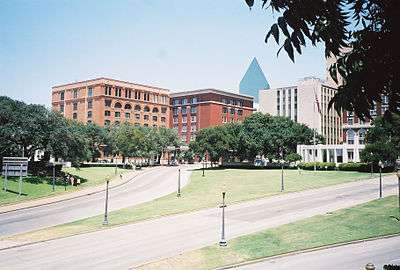Dal-Tex Building
| Dal-Tex Building | |
|---|---|
 View from southwest, with the former Texas School Book Depository Building at left, and the Dal-Tex Building, right next to it. | |
| Former names | Kingman Texas Implements Company Building, John Deere Plow Company Building |
| Alternative names | Dallas Textile Building |
| General information | |
| Status | Complete |
| Type | Brick |
| Architectural style | Sullivanesque |
| Address |
501 Elm Street Dallas, Texas United States |
| Coordinates | 32°46′43″N 96°48′30″W / 32.77861°N 96.80833°W |
| Completed | 1902 |
| Technical details | |
| Floor count | 7 |
| Design and construction | |
| Architecture firm | Hubbell and Greene |
| References | |
| [1][2] | |
The Dal-Tex Building is a seven story office building located at 501 Elm Street in the West End Historic District of downtown Dallas, Texas. The building is located on the northeast corner of Elm and North Houston Streets, across the street from the Texas School Book Depository in Dealey Plaza, the scene of the assassination of President John F. Kennedy on November 22, 1963. The Dal-Tex Building, sometimes called the Dallas-Textiles Building, the Dal-Tex Market Building, or the Dal-Tex Mart Building, was a center of the textile business in Dallas.
Designed by architects James P. Hubbell and Herbert Miller Greene as a warehouse for the Kingman Texas Implement Company, the building has been described as one of the "earliest Sullivanesque designs in Texas".[2] The building has also been reported to show the Prairie School's influence on Greene.[3]
Assassination of Kennedy
Abraham Zapruder, who shot the famous Zapruder film, had his offices on the fourth floor of the Dal-Tex Building.[4]
Conspiracy theories
Several conspiracy theories in the assassination of Kennedy allege that some of the shots fired on the President's motorcade originated from the Dal-Tex Building.[5] In September 1966, Triumph published an article by Lawrence R. Brown stating that bullet trajectories traced back to a second floor window in the Dal-Tex Building.[6] Jim Garrison told Playboy in September 1967 that the building was "in all probability" one of four locations in which assassins fired at Kennedy.[7] Garrison would later claim that there were four assassination teams, each consisting of a rifleman and a lookout, including one on the seventh floor of the building.[8] In November 1967, Josiah Thompson stated that his study led him to conclude that there were four shots from three firing positions during the assassination, and that the Dal-Tex Building may have been the location of the second shot.[9] Thompson said that a young man was arrested within minutes after the shooting, taken in for questioning by police, then disappeared in the confusion.[9]
In the May 1970 issue of Computers and Automation, Richard E. Sprague said he used computer analysis of still photographs and movie film from Dealey Plaza.[10] Implicating four gunmen and at least 50 conspirators in Kennedy's assassination, he concluded that two shots originated from the Dal-Tex Building.[10] Five years later in September 1975, Sprague and L. Fletcher Prouty stated that their study of still photographs and film of the assassination revealed that the fourth floor of the Dal-Tex Building was one of three or four firing positions during the assassination.[11]
Photo gallery
-

The Dal-Tex Building (right), across the street from the Texas School Book Depository Building
-

Warren Commission exhibit #876 showing the location of the Dal-Tex Building
See also
References
- ↑ Dallas County Historical Foundation (August 1991). "National Register of Historic Places Inventory-Nomination: Dealey Plaza Historic District" (PDF). National Park Service. Retrieved June 7, 2012. and Accompanying photos and maps, various dates (3.14 MB)
- 1 2 "Greene LaRoche and Dahl: An Inventory of their Collection, 1902-1953". Alexander Architectural Archive. Austin, Texas: University of Texas Libraries. Retrieved June 7, 2012.
- ↑ "Architectural Legacy: Dallas". The Architectural Legacy of Herbert Miller Greene. Austin, Texas: University of Texas Libraries. Retrieved June 7, 2012.
- ↑ Bloom, John (November 22, 1983). "Film a compact, chilling, suspense story". The Citizen. Ottawa. p. 12. Retrieved April 11, 2015.
- ↑ "A Second Primer of Assassination Theories". Esquire: 104 ff. May 1967.
- ↑ Chamberlain, John (November 30, 1966). "Rumors Rife In JFK Case". The Sumter Daily Item. Sumter, South Carolina. p. 8-A. Retrieved April 11, 2015.
- ↑ "Garrison Claims 'Guerilla Team Of 7' Killed JFK". The Miami News. Miami, Florida. September 11, 1967. p. 2A. Retrieved April 11, 2015.
- ↑ "Garrison Claims Foreign Help". The Milwaukee Journal. Milwaukee, Wisconsin. July 12, 1968. p. 3. Retrieved April 11, 2015.
- 1 2 Winship, Frederick M. (November 17, 1967). "Study Of Assassination Claims Conspiracy By Trio". The Bryan Times. Bryan, Ohio. UPI. p. 1-2. Retrieved April 11, 2015.
- 1 2 "Computer "Clears" Oswald; Kennedy Case Studied". Spokane Daily Chronicle. Spokane, Washington. AP. May 2, 1970. p. 1. Retrieved April 11, 2015.
- ↑ "2 Claim Conspiracy Proof in JFK's Death". Milwaukee Sentinel. Milwaukee, Wisconsin. UPI. September 4, 1975. p. 2. Retrieved April 11, 2015.
External links
Coordinates: 32°46′47.46″N 96°48′28.62″W / 32.7798500°N 96.8079500°W